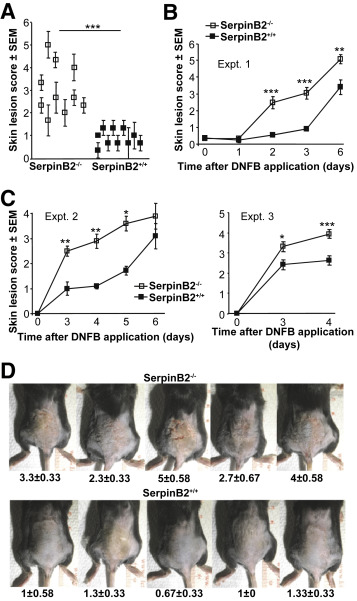SerpinB2 Deficiency Results in a Stratum Corneum Defect and Increased Sensitivity to Topically Applied Inflammatory Agents.
SerpinB2 (plasminogen activator inhibitor type 2) is constitutively expressed at high levels by differentiating keratinocytes in mice and humans; however, the physiological function of keratinocyte SerpinB2 remains unclear. Herein, we show that SerpinB2(-/-) mice are more susceptible to contact dermatitis after topical application of dinitrofluorobenzene, and show enhanced inflammatory lesions after topical applications of phorbol ester. Untreated SerpinB2(-/-) mice showed no overt changes in epithelial structure, and we were unable to find evidence for a role for keratinocyte SerpinB2 in regulating immunity, apoptosis, IL-1β production, proteasomal activity, or wound healing. Instead, the phenotype was associated with impaired skin barrier function and a defective stratum corneum, with SerpinB2(-/-) mice showing increased transepidermal water loss, increased overt loss of stratum corneum in inflammatory lesions, and impaired stratum corneum thickening after phorbol ester treatment. Immunoblotting suggested that SerpinB2 (cross-linked into the cornified envelope) is present in the stratum corneum and retains the ability to form covalent inhibitory complexes with urokinase. Data suggest that the function of keratinocyte SerpinB2 is protection of the stratum corneum from proteolysis via inhibition of urokinase, thereby maintaining the integrity and barrier function of the stratum corneum, particularly during times of skin inflammation. Implications for studies involving genetically modified mice treated with topical agents and human dermatological conditions, such as contact dermatitis, are discussed.
Authors
Wayne A Schroder; Itaru Anraku; Thuy T Le; Thiago D C Hirata; Helder I Nakaya; Lee Major; Jonathan J Ellis; Andreas Suhrbier
External link
Publication Year
Publication Journal
Associeted Project
Microbiology or Immunology
Lista de serviços
-
Genomic analyses reveal broad impact of miR-137 on genes associated with malignant transformation and neuronal differentiation in glioblastoma cells.Genomic analyses reveal broad impact of miR-137 on genes associated with malignant transformation and neuronal differentiation in glioblastoma cells.
-
RNA-Binding Protein Musashi1 Is a Central Regulator of Adhesion Pathways in Glioblastoma.RNA-Binding Protein Musashi1 Is a Central Regulator of Adhesion Pathways in Glioblastoma.
-
MicroRNA Transcriptome Profiling in Heart of Trypanosoma cruzi-Infected Mice: Parasitological and Cardiological Outcomes.MicroRNA Transcriptome Profiling in Heart of Trypanosoma cruzi-Infected Mice: Parasitological and Cardiological Outcomes.
-
Genome mapping and expression analyses of human intronic noncoding RNAs reveal tissue-specific patterns and enrichment in genes related to regulation of transcription.Genome mapping and expression analyses of human intronic noncoding RNAs reveal tissue-specific patterns and enrichment in genes related to regulation of transcription.
-
Antimicrobial peptide LL-37 participates in the transcriptional regulation of melanoma cells.Antimicrobial peptide LL-37 participates in the transcriptional regulation of melanoma cells.
-
Down-regulation of 14q32-encoded miRNAs and tumor suppressor role for miR-654-3p in papillary thyroid cancer.Down-regulation of 14q32-encoded miRNAs and tumor suppressor role for miR-654-3p in papillary thyroid cancer.
-
Integration of miRNA and gene expression profiles suggest a role for miRNAs in the pathobiological processes of acute Trypanosoma cruzi infection.Integration of miRNA and gene expression profiles suggest a role for miRNAs in the pathobiological processes of acute Trypanosoma cruzi infection.
-
Integrative Biology Approaches Applied to Human DiseasesIntegrative Biology Approaches Applied to Human Diseases
-
Proteomics reveals disturbances in the immune response and energy metabolism of monocytes from patients with septic shock.Proteomics reveals disturbances in the immune response and energy metabolism of monocytes from patients with septic shock.
-
Genomics, epigenomics and pharmacogenomics of Familial Hypercholesterolemia (FHBGEP): A study protocol.Genomics, epigenomics and pharmacogenomics of Familial Hypercholesterolemia (FHBGEP): A study protocol.
-
Melatonin-Index as a biomarker for predicting the distribution of presymptomatic and asymptomatic SARS-CoV-2 carriersMelatonin-Index as a biomarker for predicting the distribution of presymptomatic and asymptomatic SARS-CoV-2 carriers
-
Profiling plasma-extracellular vesicle proteins and microRNAs in diabetes onset in middle-aged male participants in the ELSA-Brasil study.Profiling plasma-extracellular vesicle proteins and microRNAs in diabetes onset in middle-aged male participants in the ELSA-Brasil study.
-
Big Data and machine learning in cancer theranosticsBig Data and machine learning in cancer theranostics
-
Genomic positional conservation identifies topological anchor point RNAs linked to developmental loci.Genomic positional conservation identifies topological anchor point RNAs linked to developmental loci.
-
Integrative systems immunology uncovers molecular networks of the cell cycle that stratify COVID-19 severityIntegrative systems immunology uncovers molecular networks of the cell cycle that stratify COVID-19 severity

